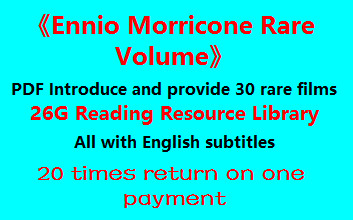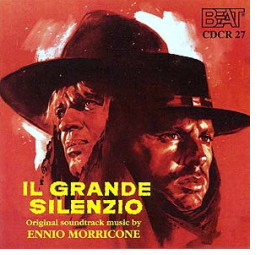IL GRANDE SILENZIO [THE GREAT SILENCE] (1968)
Il Grande Silenzio is a critically acclaimed Spaghetti western directed by the great Sergio Corbucci. The film is set in a snow-bound Utah town in the 1890s and stars French actor Jean Louis Trintignant as a gunslinger named Silence, who has dedicated himself to protecting the weak and downtrodden after witnessing his parents being murdered by bandits as a child; he survived the attack, was rendered mute by the experience, hence his name. Silence gets the opportunity to avenge his past many years later when Pollicut (Luigi Pistilli), the corrupt official who hired the bandits that killed his family, hires a new and even more vicious bounty hunter named Loco (Klaus Kinski) to kill the Utah townspeople as part of an illegal land ownership plot. It’s a complicated story, filled with political undertones, which Corbucci said were intentional commentaries on the then-recent deaths of Che Guevara and Malcolm X.
Morricone’s score for the film is one of his most conventional efforts in the western genre, playing more like a fairly straightforward dark drama without all the quirky ideas and offbeat instrumentation. Perhaps the film’s snowbound location had something to do with it; there is a vein of icy desolation running through much of the score, reflecting both Silence’s isolation and his desire for revenge.
The main theme, as presented in the opening cue “Il Grande Silenzio (Restless)” is actually quite lovely, with a pastoral tone and a lilting melody carried by strings, guitars, and almost imperceptible finger-cymbals like sound like dripping icicles. The vocals that come in during the second half of the piece, adding a layer of warmth and humanity, which is recapitulated later in the lovely “Viaggio”. However, all this warmth this is stripped away later in cues like “E l’Amore Verra,” “Voci Nel Deserto,” and the melancholy “Gli Assassini e la Madre,” which present the theme with a sense of bitterness that matches the film’s bleak, wintry setting. The poignant vocal version of theme in the second of those cues is especially impressive.
The action music in cues like “Passaggi Nel Tempo,” “Barbara e Tagliente,” and is bold and spiky, using offbeat rhythmic ideas, unusual howling vocals, trilling trumpets, and shrill, stabbing woodwinds to raise the tension and create a sense of suspense and imminent danger. There are elements of the main theme in here too, ensuring that Silence’s presence is marked.
There is a love theme too, which first appears in the cue “Invito all’Amore (Silent Love)”. This isn’t your typical romantic love, however; Morricone’s love theme for Silence is anchored by a solo violin accompanied by nervous piano textures, and has a bitter, haunted quality, as if acknowledging that Silence’s disfigurement means he will never truly know that emotion fully. Its performance in the conclusive “L’Ultimo Gesto” begins with a series of sound effects – tapped pianos, shrill strings, gurgling percussion – and gradually increases in intensity before emerging into a shattering variation at around the 3:20 mark that ends the score on an operatic, tragic note.
As is the case with all Morricone scores, Il Grande Silenzio has been released numerous times over the years, on various LPs and CDs across Europe and Asia on numerous different labels. My favored version is the one released by Italian label Beat Records in 1995, which comes with a few bonus tracks of score from the 1969 film Un Bellissimo Novembre.
Track Listing: 1. Il Grande Silenzio (Restless) (2:28), 2. Passaggi Nel Tempo (2:25), 3. E l’Amore Verra (2:00), 4. Barbara e Tagliente (2:02), 5. Prima Che Volino I Corvi (2:31), 6. Immobile (3:28), 7. Viaggio (1:53), 8. Voci Nel Deserto (2:40), 9. Gli Assassini e la Madre (3:20), 10. Invito all’Amore (Silent Love) (4:00), 11. Nel Vecchio Saloon (1:12), 12. L’Ultimo Gesto (4:25), 13. Dopo Il Martirio (01:41). Beat Records CDCR-27, 34 minutes 38 seconds.












